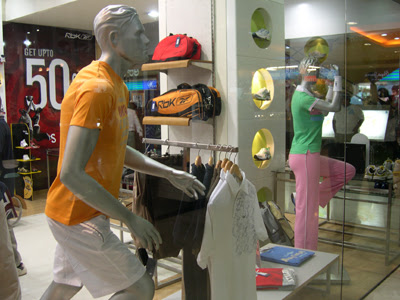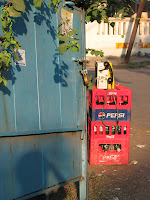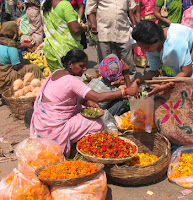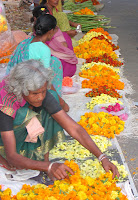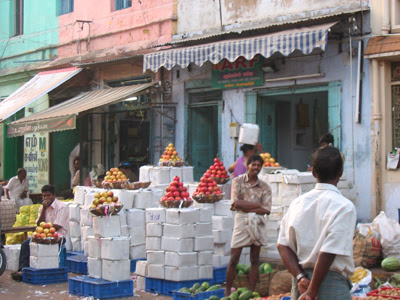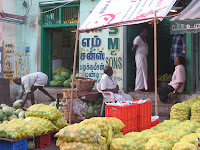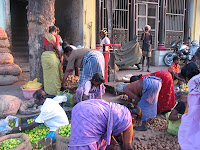Whilst developing new ideas for petty trade activities, we need to know why the prevalent conditions are unsuitable and for whom. According to the entrepreneur, there is some uncertainity in the business activity due to the lack of permanence of shelter. When there is sudden rain, some part of the activity must be stalled until such time that sunshine returns. Most of the petty traders who operate from a baddi, use it mostly as a store, for example, a cycle-repair shop or a mechanic uses the stall / baddi space to store his tools, tyres, etc.
 Almost always, the business activity stretches beyond the stall onto the open space available just outside. Either a wooden counter or table is pulled out every morning when the shop opens or a raised platform in concrete exists that serves as an extension to the stall. So, the space requirement for the business activity is very flexible and always more than 6’-0”x 6’-0”. This outdoor space may also include a waiting area for the customers which may consist of a rickety wooden bench put out onto the footpath itself.
Almost always, the business activity stretches beyond the stall onto the open space available just outside. Either a wooden counter or table is pulled out every morning when the shop opens or a raised platform in concrete exists that serves as an extension to the stall. So, the space requirement for the business activity is very flexible and always more than 6’-0”x 6’-0”. This outdoor space may also include a waiting area for the customers which may consist of a rickety wooden bench put out onto the footpath itself.
Some of the already existing baddies serve also as residences. The few belongings of the individual or family are stored inside the baddi and his workplace and sleeping quarters have the sky for roof. So, as far as the petty trader is concerned, there can be no better option than his present baddi and its outdoor extension, because it is sure value for money. He gets space free of cost outside of his 6’-0” x 6’-0” stall. In terms of facilities, the petty trader may want a toilet in the vicinity and also water supply, especially if he owns a snack or a juice stall. He, therefore needs a planned bazaar only if these facilities are provided and also if he can be better sheltered from the weather.
 As far as the municipal authorities are concerned, random growth of small businesses can create unhygienic conditions for the public due to the lack of proper drainage facilities and thus increase the health problems of the city. The footpath is not anymore just a circulation space; it also becomes a business or commercial space.
As far as the municipal authorities are concerned, random growth of small businesses can create unhygienic conditions for the public due to the lack of proper drainage facilities and thus increase the health problems of the city. The footpath is not anymore just a circulation space; it also becomes a business or commercial space.
From the point of view of the public, a planned bazaar will be more efficient to carry out shopping activities; more hygienic, at least partially sheltered and therefore shopping may be done with better protection from the harsh sun. It is possible that a new bazaar may be located further away from the buyer’s home than an existing baddi cluster. There is often a single baddi located at almost every street junction. It keeps in mind the walking distances to be covered from the buyer’s home. However, these street corner baddis are often only paan-shops stocking limited items. Other needs must be met with at shops which may be located further away. Usually, the informal growth of baddis is found to occur near a bus-stop or sometimes a temple.
It helps if the municipal authorities survey well the physical aspects of already existing petty trades such as spatial requirements, low-cost construction materials, and the unconventional servicing and infrastructural facilities in use. In the end, the designed space and shelter must be priced correctly, or else, the exercise tends to fail due to lack of interest from the petty traders in the new project.
 We were at Anegondi. The coracle was waiting. It took us along. It was like being inside a sculpture, a sculpture that flowed by the water. It was of course peaceful, no people, stone and its own ways. As we shored, it seemed like we were entering Hampi from its back door. A winding path through the overpowering stones and we were suddenly onto the street that led to the temple. This had also been the street where the main bazaar had once been. It was today also a bazaar, but a half bazaar. One end was deserted.
We were at Anegondi. The coracle was waiting. It took us along. It was like being inside a sculpture, a sculpture that flowed by the water. It was of course peaceful, no people, stone and its own ways. As we shored, it seemed like we were entering Hampi from its back door. A winding path through the overpowering stones and we were suddenly onto the street that led to the temple. This had also been the street where the main bazaar had once been. It was today also a bazaar, but a half bazaar. One end was deserted. It should be possible to experience a historic place in its 'as is, where is' condition. We often crave to know the history before we reach there, or when we are there. Without the stories of the past reaching us, how much of the present of a place is still there for us to experience?
It should be possible to experience a historic place in its 'as is, where is' condition. We often crave to know the history before we reach there, or when we are there. Without the stories of the past reaching us, how much of the present of a place is still there for us to experience?







